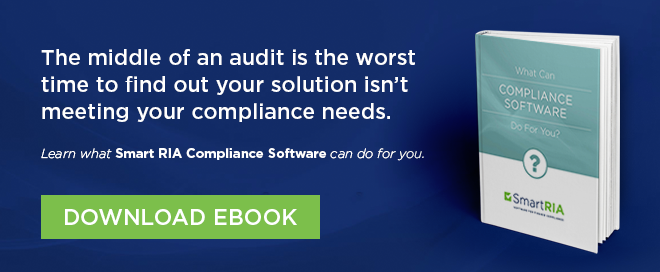
Since the U.S. Department of Labor passed its new Fiduciary Rule back in April, the investment industry has been rife with discussion and speculation.
Will it change the way we do business?
How is this different from SEC or state compliance?
Will it add to our time and labor costs?
What is even required under this rule, anyway?
Topping out at more than 1,000 pages, the DOL Fiduciary Rule is daunting and extensive, and experts in the industry are still pondering its long-range effects on investment professionals—RIAs included. Adding to the confusion, the rule (and the DOL’s authority to make such a rule) is being challenged in several lawsuits, and which direction those decisions will go is anybody’s guess.
Schedule a SmartRIA Demo Today to learn more about how we can help you stay compliant.
But in the meantime, RIAs need to educate themselves on the basics of the DOL Fiduciary Rule and put plans in place for its implementation. You’ve got some time; the phased rollout of the rule starts in April 2017, but it’s better to stay up to date with developments now and gradually introduce them at your firm rather than scrambling to meet compliance requirements later.
The Basics
The RIA Compliance Group has a great summary of the way this rule relates to RIAs. The DOL’s Fiduciary Rule is an attempt to update mandates regarding workers’ tax-exempt retirement savings. Previously, these rules hadn’t been updated since the 1970s.
The fiduciary rule redefines who is considered a fiduciary and places restrictions on those who give investment advice. It is meant to protect clients from advisors with a conflict of interest and make sure that all advice given is in the best interest of the client.
But Aren’t RIAs Already Fiduciaries?
It’s true, registered investment advisors have existing fiduciary duty and conflict of interest requirements under SEC compliance. However, as this article from Financial Planning explains, don’t underestimate the impact of the DOL Fiduciary Rule on RIAs. The DOL’s compliance standards will be new, and their documentation requirements could be more rigorous.
They’re even adding a new document to the mix, the Best-Interest Contract Exemption, or BICE. With the BICE, the advisor enters into a contract with the client promising to act in the client’s best interest, keep advisor compensation at a reasonable level, and more. And, based on the articles of the BICE contract, the client may bring a lawsuit against the advisor if they suspect they have not received the best level of care.
Yes, you read that right. The new DOL fiduciary rule could expose you to litigation, and if you get sued, you’ll need documentation to prove you acted in the client’s best interest.
Can Software Help?
Absolutely! While preparing your firm to comply with the new DOL regulations will take some time, you can cut down on the wait and protect yourself in case of litigation with a software-based compliance solution like SmartRIA.
We update our software regularly to stay in sync with the latest compliance rules, and will do so for the DOL Fiduciary Rule as well. Our secure document storage keeps each client’s records together, including the BICE, and automated alerts let you and your staff know when something is missing or a deadline is approaching.
There is no need to buy a separate platform for the new DOL regulations. SmartRIA has all your compliance needs covered. And since your staff won’t have to learn another program, you’ll save time and labor expenses as well.


